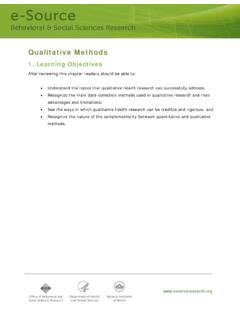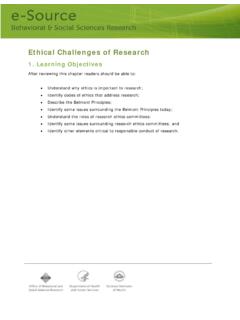Transcription of Measuring Socioeconomic Status
1 Measuring Socioeconomic Status 1. Learning Objectives After reviewing this chapter readers should be able to: Understand what Socioeconomic Status is; Appreciate the difference between a composite and a proxy measure is; Identify the three major uses of SES in research; and Appreciate the limits of SES measurement. 2. Introduction Socioeconomic Status is one of those terms typically learned in a seventh grade social studies or civics class and then used in college term papers to subtly suggest a deep understanding of how society works, or perhaps how it should work. While it is understandable that few go beyond a cursory understanding of the construct, among social scientists the term is serious business because it connotes one s position in the social hierarchy, how the hierarchy is structured, and very often one s consequent life chances.
2 In other words, Socioeconomic Status (hereinafter SES) indicates one s access to collectively desired resources, be they material goods, money, power, friendship networks, healthcare, leisure time, or educational opportunities. And it is access to such resources that enable individuals and/or groups to prosper in the social world. Social hierarchy, or stratification, appears to be intuitively recognized by most everyone everywhere (Smith et al. 2011). During social interactions various indicators are typically displayed or revealed in order to convey one s SES to other members of the social group . Common indicators include professional titles, clothing, hairstyles, automobiles, residential addresses and so forth. All social animals, be they wolves, whales, monkeys, or humans, appear to appreciate, or at least recognize, social hierarchies and their position in them (Gesquiere et al.)
3 2011; Sapolsky 2005). The level of sophistication of a hierarchy may be as simple as a pecking order based entirely on physical prowess, often with an alpha male atop. Hierarchies may also be extremely multidimensional and complex, such as contemporary human societies, with innumerate subgroups and subcultures, and with stratification built along many lines including intelligence, appearance, talent, experience, age, pedigree, language accent, work ethic, and so forth. Relatedly, the level in inequality within and between dimensions of SES varies as well (Smith et al. 2011). 2. Introduction Overview of the Research Process There is a vast array research and inquiry into the nature and process of human social stratification over time and across societies, the mobility of actors within such societies, and the implications for well-being and life chances within the same (Krieger 1997; Oakes and Rossi 2003; Spilerman 2000; Van Leeuwen and Maas 2010).
4 My take is that about half the work is devoted to descriptions and empirical facts about how a given society is stratified, and half is devoted to how a given society should be stratified, if at all. In any case, this is not the place to review the work or offer a serious taxonomy of it. Many contemporary scholars appear interested in SES because it serves as an indicator of the health of a social system or society, often measured against some egalitarian or meritocratic ideal. Informally stated, the meritocratic ideal is that regardless of birth right or inherited endowments, individuals may increase their SES through effort, including but not limited to the development of their inherited endowments (Bowles, Gintis and Wright 1998) . Societies without such potential are often viewed as less healthy if not backwards.
5 For meritocrats and egalitarians alike, stratification based on birth ( , luck) or discrimination based on race, gender, religious ideology, or ethnic background are anathema to social or civil progress (Arrow, Bowles and Durlauf 2000). 2. Introduction Another group of contemporary scholars seems interested in SES in order to rule out the long established effects of SES on various measures of well-being and life outcomes. For this group, SES is a nuisance variable; one that must be controlled for or eliminated as a potential explanation of research findings or theoretical arguments. Here, SES is of interest only so far as it eliminates effects that confound the exposures or treatments of direct interest. Given that there are volumes written on the topic, what follows should be viewed as a pragmatic summary for the applied researcher, by an applied research.
6 In the main, I shall try to offer a few helpful citations to other work for readers interested in a deeper understanding. What is more, it is important to stress that my own work is largely focused around the relationship between SES and health in contemporary America. Consequently, this chapter is necessarily biased in this direction. I regret that I am not sufficiently skilled in the workings of other societies or time periods to do such work justice. The aim of this chapter is to present and review some contemporary measures of SES and to offer recommendations about how best to think about and use such measures and those like them. 3. What is Socioeconomic Status ? It may surprise some but the fact is that there is no agreed upon definition of SES, and in my view there will never be.
7 This is because the construct necessarily entails political ideologies about existing and desired social structures, and political ideologies and science do not mix well. For the last three decades or so, some scholars have defined SES as equivalent to simple, measurable things such as annual income. Others think race or ethnicity should be included. Some believe health Status should be part of an SES measure since SES and health are so highly correlated and clearly cause each other. Few are certain how to assign SES to those not in the labor force, such as children, the elderly, or those who have intentionally dropped out. In sum, for a term that appears to be universally understood and employed it is profoundly ironic that its scientific underpinning is so under-developed. It is access to such resources that enables individuals and/or groups to thrive in the social world.
8 Those with higher SES tend to thrive and many aim to improve their SES or the SES of their offspring in order to improve their life chances. Although too often correlated with it, I do not think race or ethnicity are part of one s SES (Kaufman, Cooper and McGee 1997; Oakes and Rossi 2003). One should be able to improve their SES without changing their phenotype (including skin color) or linguistic accent. Further, I do not think health should be a part of SES, though health certainly affects SES. As with race/ethnicity, incorporating health into SES measures prevents our ability to discuss health outcomes by SES. Of course, phenomena such as racism disrupts social mobility and is therefore related to SES. Further, it is well established that poor health can cause down-turns in maintain that SES is a construct that reflects one s access to collectively desired resources, be they material goods, money, power, friendship networks, healthcare, leisure time, or educational opportunities (Oakes and Rossi 2003).
9 3. What is Socioeconomic Status ? There are a few terms that are similar to SES and many of these are used as synonyms. Accordingly, it seems best to offer a brief comment on them. The first is social class. Social class is a construct or measure that, like SES, aims to locate one s position in the social hierarchy. But unlike the multidimensional and often finely graded (continuous scale) aspects of SES, measures of social class are typically coarse and limited to one s relationship to the so-called means of production. Marxist in origin, social class measures tend to classify persons according to whether they own or control a business (or school!) or whether they are laborers in such places (Krieger 1997; Wright 1985).
10 In any case, the understanding and use of social class is not unlike the use of SES and for purposes here, at least, I believe it is fair to use the terms synonymously. Instead of SES, European scholars tend to use term Socioeconomic position (SEP) ( Galobardes et al. 2006). I also view these two terms as synonyms. I actually prefer SEP because, among experts, SES tends connote meanings limited to occupational prestige, which is a largely outdated idea. Yet in practical terms the distinction between Status and position seems trivial. But since I m intellectually biased toward American scholarship I use the term SES here and elsewhere. 3. What is Socioeconomic Status ? Though used less often, the term caste is also related to SES because caste tends to convey one s social class, Status , or position.











